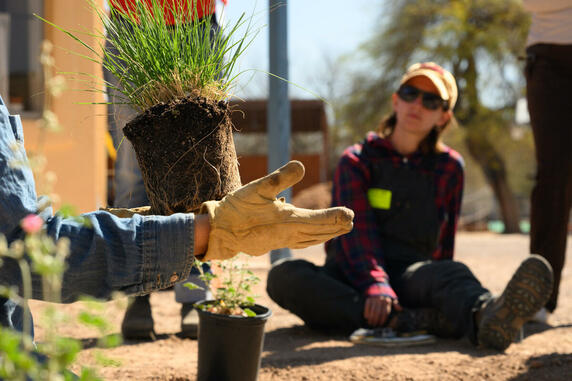
I told many friends I was taking a water harvesting design certification course this spring. I got back many kind-but-honest texts: So cool! What is that?
At first, I picture a big plastic rain tank. It’s sitting off to the side of a bare yard, baking in the sun. It’s technically doing something good—collecting water—but it feels a little disconnected, like a gadget added onto a home rather than something alive within it.
Now, scratch that image and imagine a lush, green oasis with walking paths and gently sloped basins. Ironwood trees stand at the edge of each basin, creating shade for humans and canopies for animals. Brittlebush and milkweed sit beneath the trees. Native grasses and wildflowers sit at the bottom. You can tell water has stayed here a while moving slowly, soaking in, supporting life.
That’s water harvesting too—but done in a way that’s deeply intentional and rooted in place.
On day one of the cert course, Brad Lancaster said water harvesting shouldn’t just be a solution to our collective problems like prolonged drought or heat island effect. The best water harvesting system should, instead, invite us to live with nature more intentionally. I learned that the most “pretty” and expensive systems are often the most degenerative systems. In other words, those tanks start decomposing the moment they’re installed. And most of the time, we don’t know how to use all the precious water we’ve collected. A well-designed rain garden or curb cut can quietly recharge groundwater, cool the surrounding area, and bring pollinators and birds back into a neighborhood. These systems don’t just do something good; they invite people to notice, to participate, and to reconnect.
Moving on from the course and my WMG apprenticeship as an environmental educator, I’m inspired to build “beneficial ruins,” systems like rain gardens that give back to our soils, plants, and animals more than they take. They don’t have to be flashy. They just have to work with the land instead of against it.
I want water harvesting to be a household word. I want my future texts to say not just So cool! What is that?—but So cool! What next?
Marisa is Watershed Management Group's Environmental Education Apprentice with a background in teaching creative writing. She’s passionate about sustainability, collective care, and empowering water-wise action. Outside of work, she enjoys songwriting, cooking vegan-ish meals, rock climbing, and community connection.





